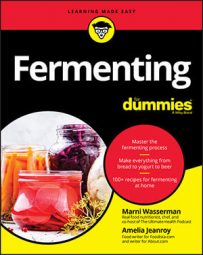The fundamental things you need to ferment foods are often the same, but there are many variations of those ingredients that can change your results.
Fermenting containers: Fermented foods must be made without the presence of oxygen or spoilage will occur. A good fermenting container is essential to your success. Use a sturdy container that's large enough to hold your fermented goods.
Containers are best made from glass, like Mason jars, or nonreactive materials, such as a crockpot made from ceramic or a well-cleaned plastic bucket. The key to fermentation is creating an anaerobic, or oxygen-free, environment by sealing out any outside air.
Look for fermentation jars with an airlock seal that allows gas to escape but no air to get inside, though in some recipes a weighted lid will do the trick.
Lactobacilli: These naturally occurring bacteria are essential to the fermentation process. These good bacteria have been proven to fight intestinal inflammation and help create a healthy gut. They also enhance the flavors and digestibility of fermented foods — they're the invisible workers that make your food ferment!
Salt: Salt can kill any bacteria that may cause illness. It does this by creating a less inhabitable environment by removing water from the plant cells. Salt also helps enhance the flavors of food. It can reduce sweetness or bitterness in foods, a desirable thing for your recipes!
Spices and herbs: You add herbs and spices to your fermented foods to create unique recipes. Think of adding ginger to your kombucha, cranberries to your sauerkraut, or caraway seeds to your pickled goods!
A starter or a culture: Many fermented recipes ask for a starter or a culture. A fermentation starter can come in the form of a dried powder, yeast, or a wet substance and is essentially used to boost the food's flavor and the digestion process.
You can get good results using a kick-start from a previous batch to accelerate the fermentation process. You can purchase starters or, depending on the product, reuse them from other food products like sourdough or yogurt.
Sugar: You use sugar to help preserve foods when salt would be undesirable. (Imagine making jam or kombucha with salt. Yuck!) Most commonly used in wet brine, sugar can include cane sugar, honey, or maple syrup.
Time: Every good fermented food product needs time. The tiny microbes will work to turn those starches into sugars and alcohol and will only slow down if you place them in cooler temperatures. Depending on the end product, you'll leave your ferments anywhere from two to seven days, or longer! Check your recipe and taste your food according to the flavors you desire..

